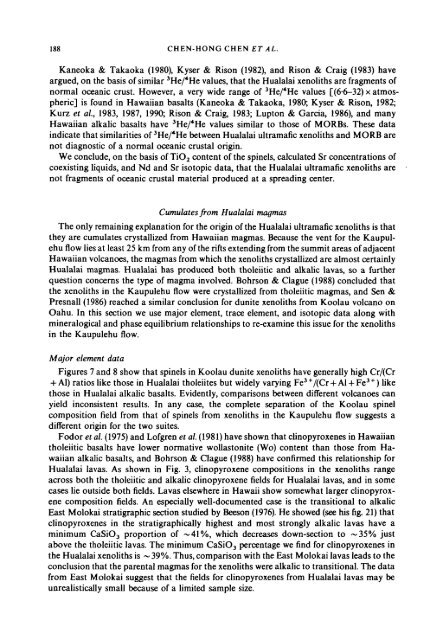Petrogenesis of Ultramafic Xenoliths from the 1800 Kaupulehu Flow ...
Petrogenesis of Ultramafic Xenoliths from the 1800 Kaupulehu Flow ...
Petrogenesis of Ultramafic Xenoliths from the 1800 Kaupulehu Flow ...
You also want an ePaper? Increase the reach of your titles
YUMPU automatically turns print PDFs into web optimized ePapers that Google loves.
188 CHEN-HONG CHEN ET AL.Kaneoka & Takaoka (1980), Kyser & Rison (1982), and Rison & Craig (1983) haveargued, on <strong>the</strong> basis <strong>of</strong> similar 3 He/*He values, that <strong>the</strong> Hualalai xenoliths are fragments <strong>of</strong>normal oceanic crust. However, a very wide range <strong>of</strong> 3 He/*He values [(6-6-32) x atmospheric]is found in Hawaiian basalts (Kaneoka & Takaoka, 1980, Kyser & Rison, 1982;Kurz et al, 1983, 1987, 1990; Rison & Craig, 1983; Lupton & Garcia, 1986), and manyHawaiian alkalic basalts have 3 He/ 4 He values similar to those <strong>of</strong> MORBs. These dataindicate that similarities <strong>of</strong> 3 He/*He between Hualalai ultramafic xenoliths and MORB arenot diagnostic <strong>of</strong> a normal oceanic crustal origin.We conclude, on <strong>the</strong> basis <strong>of</strong> TiO 2 content <strong>of</strong> <strong>the</strong> spinels, calculated Sr concentrations <strong>of</strong>coexisting liquids, and Nd and Sr isotopic data, that <strong>the</strong> Hualalai ultramafic xenoliths arenot fragments <strong>of</strong> oceanic crustal material produced at a spreading center.Cumulates <strong>from</strong> Hualalai magmasThe only remaining explanation for <strong>the</strong> origin <strong>of</strong> <strong>the</strong> Hualalai ultramafic xenoliths is that<strong>the</strong>y are cumulates crystallized <strong>from</strong> Hawaiian magmas. Because <strong>the</strong> vent for <strong>the</strong> <strong>Kaupulehu</strong>flow lies at least 25 km <strong>from</strong> any <strong>of</strong> <strong>the</strong> riftsextending <strong>from</strong> <strong>the</strong> summit areas <strong>of</strong> adjacentHawaiian volcanoes, <strong>the</strong> magmas <strong>from</strong> which <strong>the</strong> xenoliths crystallized are almost certainlyHualalai magmas. Hualalai has produced both tholeiitic and alkalic lavas, so a fur<strong>the</strong>rquestion concerns <strong>the</strong> type <strong>of</strong> magma involved. Bohrson & Clague (1988) concluded that<strong>the</strong> xenoliths in <strong>the</strong> <strong>Kaupulehu</strong> flow were crystallized <strong>from</strong> tholeiitic magmas, and Sen &Presnall (1986) reached a similar conclusion for dunite xenoliths <strong>from</strong> Koolau volcano onOahu. In this section we use major element, trace element, and isotopic data along withmineralogical and phase equilibrium relationships to re-examine this issue for <strong>the</strong> xenolithsin <strong>the</strong> <strong>Kaupulehu</strong> flow.Major element dataFigures 7 and 8 show that spinels in Koolau dunite xenoliths have generally high Cr/(Cr4-Al) ratios like those in Hualalai tholeiites but widely varying Fe 3+ /(Cr-I-Al + Fe 3 + ) likethose in Hualalai alkalic basalts. Evidently, comparisons between different volcanoes canyield inconsistent results. In any case, <strong>the</strong> complete separation <strong>of</strong> <strong>the</strong> Koolau spinelcomposition field <strong>from</strong> that <strong>of</strong> spinels <strong>from</strong> xenoliths in <strong>the</strong> <strong>Kaupulehu</strong> flow suggests adifferent origin for <strong>the</strong> two suites.Fodor et al. (1975) and L<strong>of</strong>gren et al. (1981) have shown that clinopyroxenes in Hawaiiantholeiitic basalts have lower normative wollastonite (Wo) content than those <strong>from</strong> Hawaiianalkalic basalts, and Bohrson & Clague (1988) have confirmed this relationship forHualalai lavas. As shown in Fig. 3, clinopyroxene compositions in <strong>the</strong> xenoliths rangeacross both <strong>the</strong> tholeiitic and alkalic clinopyroxene fields for Hualalai lavas, and in somecases lie outside both fields. Lavas elsewhere in Hawaii show somewhat larger clinopyroxenecomposition fields. An especially well-documented case is <strong>the</strong> transitional to alkalicEast Molokai stratigraphic section studied by Beeson (1976). He showed (see his fig.21) thatclinopyroxenes in <strong>the</strong> stratigraphically highest and most strongly alkalic lavas have aminimum CaSiO 3 proportion <strong>of</strong> ~41%, which decreases down-section to ~35% justabove <strong>the</strong> tholeiitic lavas. The minimum CaSiO 3 percentage we find for clinopyroxenes in<strong>the</strong> Hualalai xenoliths is ~39%. Thus, comparison with <strong>the</strong> East Molokai lavas leads to <strong>the</strong>conclusion that <strong>the</strong> parental magmas for <strong>the</strong> xenoliths were alkalic to transitional. The data<strong>from</strong> East Molokai suggest that <strong>the</strong> fields for clinopyroxenes <strong>from</strong> Hualalai lavas may beunrealistically small because <strong>of</strong> a limited sample size.
















